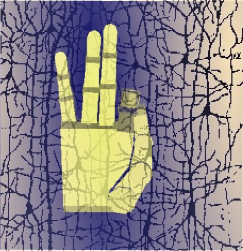 The goal of this project is to investigate the principles underlying co-evolution of a body shape and its neural controller. As a specific model system, we consider a robot hand that is controlled by a neural network. In contrast to existing work, we focus on the genetic regulation of neural circuits and morphological development. Our interest is directed at a better understanding of the facilitatory potential of co-evolution for the emergence of complex new functions, the interplay between development and evolution, the response of different genetic architectures to changing environments, as well as the role of important boundary constraints, such as wiring and tissue costs.
The goal of this project is to investigate the principles underlying co-evolution of a body shape and its neural controller. As a specific model system, we consider a robot hand that is controlled by a neural network. In contrast to existing work, we focus on the genetic regulation of neural circuits and morphological development. Our interest is directed at a better understanding of the facilitatory potential of co-evolution for the emergence of complex new functions, the interplay between development and evolution, the response of different genetic architectures to changing environments, as well as the role of important boundary constraints, such as wiring and tissue costs.
read more »











































